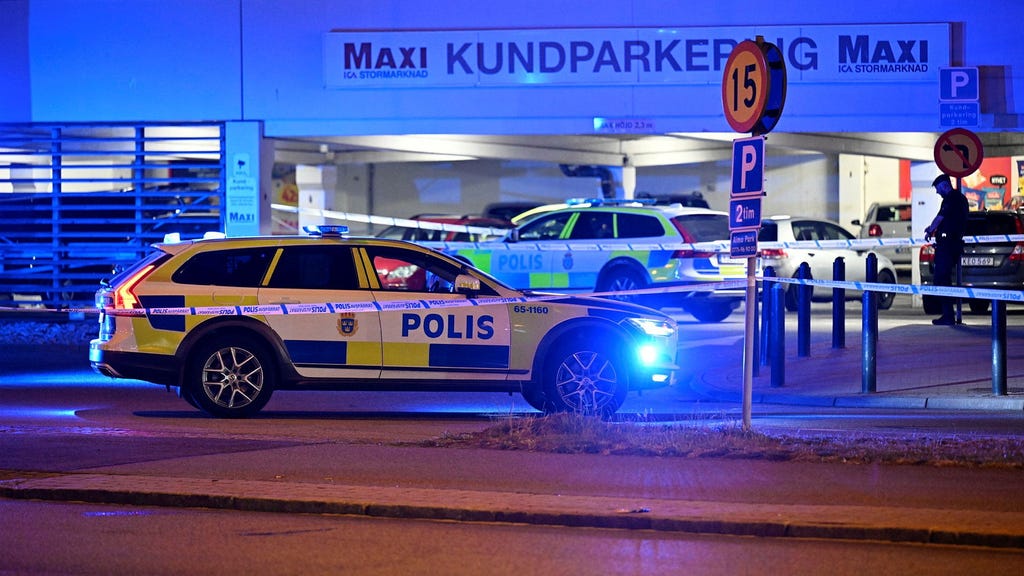The tranquil evening in the Hindby district of Malmö was shattered by the piercing sound of gunfire in a parking garage adjacent to the local Ica Maxi supermarket. A 27-year-old man, patiently waiting in his car with his young daughter while his wife shopped inside, became the victim of a brutal attack. A masked assailant emerged, unleashing a volley of bullets that struck the man in the head, face, torso, and shoulder. Horrified shoppers witnessed the terrifying scene unfold, their peaceful evening routines violently disrupted. One frantic witness, witnessing the aftermath of the shooting, immediately contacted emergency services, reporting the incident and expressing fear for the child potentially present in the car. Tragically, despite immediate medical attention, the man succumbed to his injuries. The young girl, narrowly escaping the hail of bullets, survived the ordeal, though several shots passed dangerously close, one even stopped by the car door lock near her seat.
The victim, known to local authorities for his involvement in Malmö’s gang scene, had previously been acquitted of a separate murder charge in 2017. This connection immediately raised suspicions of a gang-related motive for the attack. Following extensive investigations, two men, both with known ties to criminal networks, were apprehended and subsequently charged in connection with the shooting. A 30-year-old man faced charges of murder, attempted murder of the child, and serious weapons offenses. The second suspect, a 29-year-old man, was charged with aiding and abetting murder, aiding and abetting attempted murder, and serious weapons offenses.
The subsequent trial, held amidst heightened public interest, revealed the complexities and challenges of prosecuting cases involving gang violence. The prosecution presented their case, emphasizing the gravity of the crimes and the potential danger posed to the young girl. Key evidence against the 30-year-old defendant included DNA traces found on a spent cartridge casing recovered from the crime scene. However, the defense argued that this evidence alone was insufficient to conclusively prove his direct involvement in the shooting. The possibility of contamination or other explanations for the presence of his DNA could not be definitively ruled out.
In a surprising turn of events, the Malmö District Court delivered a verdict of acquittal for the 30-year-old defendant. The court acknowledged the incriminating nature of the DNA evidence but concluded that it did not establish beyond a reasonable doubt that he was the shooter. The possibility of other individuals being involved in the shooting could not be dismissed. The 29-year-old defendant was also acquitted of the charges related to the murder and attempted murder but was found guilty of serious weapons offenses based on video evidence of firearms found on his mobile phone, resulting in a two-year prison sentence.
The court’s decision sparked debate and raised questions about the challenges of securing convictions in gang-related cases. While the court affirmed the intentional nature of the killing, it questioned whether the perpetrator had even realized the presence of the child in the car, casting doubt on the attempted murder charge. The intricate web of relationships and alliances within the criminal underworld often makes it difficult for authorities to gather conclusive evidence and secure witness testimonies. The fear of retaliation and the code of silence that pervades these communities further complicate investigations.
The aftermath of the shooting left the community shaken, grappling with the senseless violence that had invaded their lives. The case highlighted the ongoing struggles faced by law enforcement in combating gang-related crime, emphasizing the need for continued efforts to disrupt these networks and hold perpetrators accountable. The verdict, while leaving many questions unanswered, served as a stark reminder of the complexities of justice and the challenges in bringing closure to victims and their families. The tragic event underscored the urgent need for comprehensive strategies to address the root causes of gang violence and create a safer environment for all residents.














